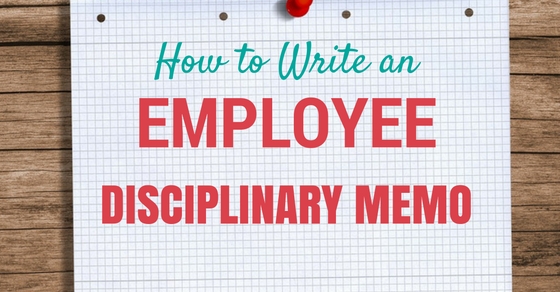An employee disciplinary memo is a statement made on behalf of a hosting company on an employee who has stepped out of line or broken company rules while at work.
A memo for disciplinary action only hands to an employee when things have gone too out of hand to control verbally.
Since an employee disciplinary memo is about taking strict actions against an employee whose behavior or performance has done more harm than good to the company, it has to be drafted with great care.

Disciplinary Memos:
When an organization needs to exchange or share information, there are many methods out of them the two most important ones are,
- Business formal letter which is used for external purposes
- Business memorandum used for internal purposes.
A business formal letter is used when the company intends to share information or exchange information to other organizations or clients. On the other hand, a business memorandum is used to share information within the company, i.e with the employees. Here the information can be of any type like important changes, new plans, bigger incorporation, etc.
Now when talking about memos, there are different types of memos and each one caters different roles
Types of Disciplinary Memos:
- Disciplinary memo
- Response to an inquiry memo
- Request for action memos
- Announcement memos
- Confirmation memos
- Financial memos
- Operational memos
- Budget memos
Types of Disciplinary Actions for Employees:
A disciplinary memo is a type of memo that contains information that triggers immediate response accordingly. Some of the types of disciplinary actions are
- Written warning.
- Verbal warning.
- Suspension.
-
- Termination
- Demotion
- Pay reduction
Disciplinary Procedure at Work:
When a disciplinary action needs to be performed, the organization usually works according to a defined protocol. An employee can avail all the procedures through an employee handbook in which all the details regarding it will be present.
Now the usual procedure for disciplinary action would be,
- Giving out a letter related to the issue
- Schedule a meeting for discussion
- Draw a final conclusion
- Provide a chance to reconsider the decision
How to Start a Disciplinary Memo:
The steps to start disciplinary memos are as follows,
- The document should be labeled CONFIDENTIAL at the top
- Detail about the problem or issue including the time and date of when it had happened
- Write down about the effect which resulted due to the problem
- List out the follow-up procedures and expected results
- Finally adding the consequences due to the violation of rules
Every little factor leading to whatever has arisen has to be taken into account while writing the memo. The following guidelines for writing a disciplinary memo can give you a better idea of what to include in it:
Tips for Writing Employee Disciplinary Memo:
1. Use the right technical language:
The use of correct technical language is essential for writing the memo. You cannot simply overlook the need for the right kind of language meant to be used on legal paperwork.
However, a disciplinary memo to write very differently from any other legal forms and notices. You cannot make it fall in line with anything else you have written on behalf of your company before, except if it was also a disciplinary memo.
But the contents every time will be different depending on what causes the need for drafting the memo. Due to the change of subject owing to different kinds of mistakes made by employees, the language keeps changing to suit the style of statement.
2. Ask for help when needed:
Writing a disciplinary memo can be quite a difficult task. It may seem all the more difficult since you are going to type off against someone who works with you. Every so often the person on the radar turns out a close friend which makes it very difficult to figure out what to write without appearing cold hearted.
Besides this, you may even clueless about how to decide on the protocol that needs to follow as to what the employee has done. But if you take all of this on yourself thinking that you are better off not taking help from a senior or a mentor because it is your job to know, then that can make things worse.
None of us would want to accept help unless we have no choice but being over-confident and too stubborn to accept help from others when there is no other option that will drop you down.
3. Consulting a sample memo or form:
You can choose to check with a disciplinary action memo sample if you confuse about what to write. Looking at some sample disciplinary action memo is nothing to ashamed of if you are at a loss for words. It is always better to be sure than making a mistake in overconfidence. There are plenty of formats available on the internet to take help from.
Moreover, company booklets have all the information in detail on how to draft a statement on every possible occasion. All the same, comparing your memo with samples lowers the risk of making mistakes.
So it is better to refer to the ways mention in formatted samples than to get your mistakes to point out by higher officials.
4. Writing about performance issues:
Employees usually punished for disciplinary memos due to their lack of performance. So try to include why the employers think that the concerned employees should have to face this. Make a note of the mistakes he/she has made over time to attract the negative attention of the higher up.
Getting a memo is not sudden, it takes a long time sometimes even after being excused for years. So it should not too hard to find why the employee deserves to abide by the norms of the memo.
If it is because of performance related issues then point out where he/she has gone wrong too many times to be excused any longer. Normally a memo does not issue until the warnings are ignored by the employee for too long.
5. Writing about behavioral issues:
Not having good behavior at work is bound to get employees in bad books. No company wants to spoil its reputation by hiring employees who cannot behave themselves.
So another reason why employee disciplinary memo is necessary is because of behavioral reasons. Employees who are out of line or misbehave with their colleagues are often said and they’ve to face the music.
Drafting a memo on the behavioral issues of an employee is quite a task. You need to gather all the complaints from all the victimized colleagues who decided to tell on the person at fault.
6. Mention in no uncertain terms the reason the employee is receiving a memo:
A disciplinary memo does not drop out of the blue. The employee must have been a continuous disappointment for the employers and the company as a whole. Employers would only turn to such a harsh option only when things are about to get out of hand.
Otherwise, as in every normal situation, they try to solve the matter by talking it out with the concerned employee. But when things start going for the worse the accused cannot be let off so easily.
So your task would be to state every word on why action is being taken against the employee very carefully. More often than not things get lost in translation so make sure you have made a note of exactly what your employers have said. Mention every reason as to why the employee hand a disciplinary memo.
7. Make a performance improvement plan (PIP):
Take every word of advice the head of the department has to offer on what to do in case you have to charter a disciplinary memo. Most often the employee under surveillance has to follow a hard and fast improvement plan. And it will come down to you to make every inch of the plan from what your employer tells you.
Things would be best if you take help from the company book of rules since it will most probably be the best possible way to figure out how to make an effective PIP.
Improvement plans have to do with sending the employee back to work as soon as possible on the word that he/she won’t make the same mistake again.
In this PIP program employees are told to improve performance. And it, as a rule, has stages for the employee to gauge improvement in their behavior and performance.
8. Considering the severity of the circumstances:
Do not ever try to take the whole matter into your own hands. Always speak to your senior before deciding what to finally put in the memo. Your seniors would probably have a better idea about how the situation to deal with.
Moreover, a memo asks to made only when there are too many problems with the employee concerned. So unless a lot of people are having trouble with the person there would be no need to draft a memo.
Therefore decisions are usually made on the severity of the circumstances and your seniors may also think it necessary to have your opinion on the matter. When a man’s career depends on what you have to say in the matter you cannot hope to pass a quick judgment.
9. Deliver the news personally:
Normally the employee to whom the memo address not informed about it beforehand. It is against company rules to tell employees that they are about to get a disciplinary memo for their mistakes.
So depending on the severity of the offense, the action taken. A memo like that is most likely to change anybody’s career path upside down. So it’s better that you deliver the news personally when the memo is a pass.
The employee despite what he/she has done will take less offense on receiving the news in person rather than electronically. This way of delivering the memo has more impact than any other way since it makes the employees feel more ashamed of one’s misdeed.
10. Always keep a document:
Always keep a second copy of every important document for future use. You never know what might come up or how badly an employee would take being handed a disciplinary memo.
A disciplinary memo comes with problems if the employee is unwilling to consort to the allegations made in the memo. This can be a very drawn out process if the employee is not willing to admit his fault and wants to take legal actions against the company.
At times like that, you will need to present every possible document in the court of law to prove that the allegations were completely true.
Even in case of a retraction, you will need to refer to the memo code and to do that you will have to keep every piece of document in place.
11. Do not take matters personally:
Things may start to get personal if the person reprimand is someone you are close to. But do not let personal relations rule your head.
If you let personal reasons get into your head and make the decisions for you then you would never be able to see yourself as loyal anymore to the company. Having said, do not let a personal rivalry get the best of you if someone you don’t like at the company is receiving a memo.
Do not take out your issues out on somebody just because you have got a chance to use unfair means to take revenge for whatever the person has done to you.
12. Medium and mode of writing:
This is a simple company decorum. You have to write in the medium the company has confirmed in the rulebook. The medium of language chose by the company is not going to go against the constitution of America.
Also, keep in mind that you suppose to keep your emotions at bay while considering the consequences for the employee concerned if you happen to know the person. If the company heads any kind of a foul play on your part, then it will be your head next on the chopping block.
However, if you are still none the wiser then ask somebody who is experienced in the matter and can help you make the right decisions for the employee and the company.
13. Always run it by the head of the company:
Make sure you’ve got the memo checked at least twice by the head of the company before getting it printed.
Even if you think that you are the best at the job and that you have left no stone unturned to point out all the right things that needed to be said, you should still run it by your mentor or the head.
Do not be so confident that you don’t feel that it is necessary to ask more experience, people, if there is anything else to add.
There is always the possibility that you might make a mistake which could avoid only if you had the sense to ask for help from your senior.
14. Quote from the company rule book:
Substantiate the memo by quoting as much as you can from the company rule book. You can hold a clearer picture of the employee if you can compare all his/her mistakes to the norms of violation and misconduct stated in the company rule book.
Moreover, the memo becomes much easier to write when you can gather up solid reasons for why the employee has to face the music. And if you quote heavily from the rule book there is very little chance that the employee would be able to deny having made the mistakes mentioned in the memo.
Conclusion:
There is a given format that needs to be followed while drafting an employee disciplinary memo depending on the sort of allegations brought down on the employee.
In addition to the above-given points, you may even look for different templates or samples of disciplinary memos that are available in pdf on the internet for visual aid.











































